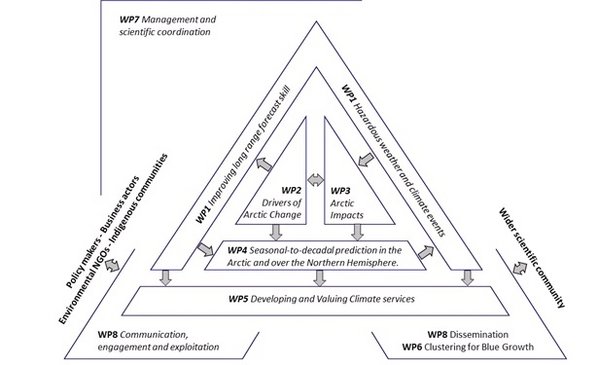Work Packages
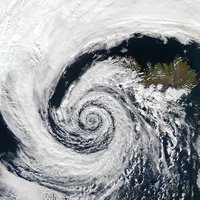
Work package 1: Improving seasonal long-range forecast skill of risks for hazardous weather and climate events.
Climate change increases the likelihood of extreme weather events such as storms and heat waves, but because they are so infrequent, they are very difficult to predict. This work package explores specialised statistics such as extreme value theory to improve our predictions of these events. It also explores whether the probability of extreme events, such as polar lows, can be related to larger scale meteorological events, such as marine cold air outbreaks. The work done in this package is closely related to the shipping case study.
The lead is Johanna Baehr at the University of Hamburg. Co-lead is Jens Hesselbjerg Christensen, who is affiliated to NORCE and NBI.
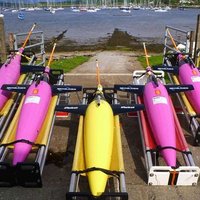
Work package 2: Lower latitude drivers of Arctic changes.
Warming in the Arctic is affected by warm ocean waters travelling from lower latitudes, but the mechanisms are not well understood. This work package uses data from international ocean observing systems, from underwater gliders to Argo profiling floats, that measure the salinity and flow of the water. These data are used to improve simulations of how heat and freshwater transfer occurs from subpolar gyres to the Arctic regions. This work package also identifies gaps in our current ocean observing systems, and provides feedback on the volumes of data required for accurate modelling.
The lead is Karin M. H. Larsen at the Faroe Marine Research Institute. The co-lead is Gerard McCarthy at the National University of Ireland Maynooth.
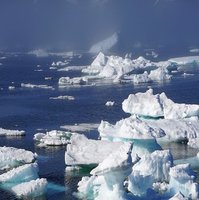
Work package 3: Linkages of Arctic climate changes to lower latitudes.
The warming Arctic causes changes in the ocean and atmosphere that can influence the weather and climate of lower latitudes. This work package investigates the potential effects of these changes, through state-of-the-art ocean, atmosphere or coupled models. Atmospheric models study the interplay between Arctic warming, the polar vortex, the jet stream and atmospheric planetary-waves. Ocean models study the release of freshwater from melting sea ice and the effect on ocean circulation, such as the Atlantic Meridional Overturning Circulation (AMOC).
The lead is Guillaume Gastineau at the Centre Nationale de la Recherche Scientifique.
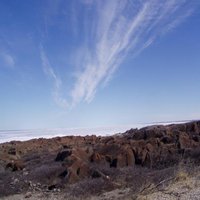
Work package 4: Enhancing the capacity of seasonal-to-decadal prediction in the Arctic and over the Northern Hemisphere.
A key aim of many climate models is to be able to predict future climate. This work package involves making assessments of the processes underlying the linkages between the Arctic and lower latitudes, and their representation in current prediction systems. The aim is to develop more advanced statistical bias correction and calibration techniques to enhance predictability of climate and extreme weather events in the Northern hemisphere.
The lead is Daniela Matei at the Max Planck Institute for Meteorology. The co-lead is Noel Keenlyside at the University of Bergen.

Work package 5: Developing and valuing climate and information services.
Often the outputs from climate models are difficult to understand and put to use for individuals and small businesses. This work package works with stakeholders to codesign methods of translating outputs from climate models into useable products. These is highlighted through a series of five specific case studies, covering sectors as diverse as tourism, mortality, shipping, fisheries and sustainable economic development. This work package also brings together the lessons learned from each case study to identify the need for future climate services.
The lead is Mark R. Payne at the Danish Meteorological Institute. The co-lead were Kathrin Stephen adn Vilena Valeeva at the Institute for Advanced Sustainability Studies.

Work package 6: Clustering.
Blue-Action has established a strong clustering activity with the European and international scientific communities focussing on climate services, Arctic impacts and Blue Growth. This work package supports the exchange and interaction between the products and services that Blue-Action delivers and the communities focusing on those themes. The goals of this work packages are to identify open research questions/development needs, to create synergies between these projects, to share knowledge and support knowledge transfer. For more details see our clustering page.
The lead is Steffen Olsen at the Danish Meteorological Institute. Co-lead is Jens Hesselbjerg Christensen, who is affiliated to NORCE and NBI.

Work package 7: Management.
This work package coordinates and manages the project. The governance structure of the project comprises a General Assembly (GA), a Steering Committee (SC), a coordinator and a project office. In addition, two external advisory bodies, in the form of a Research and Innovation Advisory Group (RIAG) and Societal Engagement Group (SEG) provide guidance to the project and foster dissemination and uptake of project results. For further details on the management structure see our  governance page, or for individual roles see our
governance page, or for individual roles see our  teams page.
teams page.
The lead is Steffen M. Olsen at the Danish Meteorological Institute. Project manager is Chiara Bearzotti (chb @ dmi.dk) at the Danish Meteorological Institute.

Work package 8: Communication, Dissemination, Engagement and Exploitation.
Effective two-way communication and knowledge exchange with stakeholders is fundamental to the success of the project. Key communities relevant to Blue-Action include business sector end users, project partners, public and wider society, policymakers, European Commission services, climate science higher Education leaders, and the wider scientific community. This package uses the case studies created in work package 5 with best practice in work package 6 to maximise impact from the project, and supports all partners to reach wider audiences.
Lead: Hannah Grist at SAMS Research Services Ltd and Pernille Martiny Modvig at Climate-KIC.
